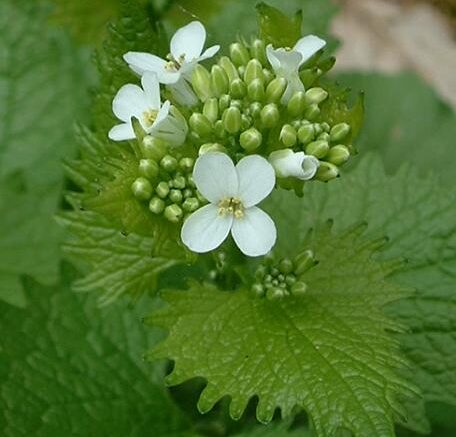Alliaria Heist. Ex Fabr. – Genus
Order: Brassicales Bromhead
Family: Brassicaceae Burnett
Tribe: Alliarieae
The genus Alliaria includes very few species and not all sources agree with the number of species currently to be included in it.
According to Plants Of the World Online, there are two accepted species: Alliaria petiolata (M.Bieb.) Cavara & Grande and Alliaria taurica (Adam) V.I.Dorof. [POWO]
According to World Flora Online, three accepted species belong to the genus Alliaria: Alliaria petiolata (M. Bieb.) Cavara & Grande, Alliaria brachycarpa M.Bieb. (considered a synonym of Alliaria taurica (Adams) V.I.Dorof. by Plants Of the World Online) and Alliaria taurica (Adams) V.I.Dorof. [POWO, WFO]
Wasabi (now classified as Eutrema wasabi (Miq.) Koidz.) has Alliaria wasabi (Maxim.) Prantl as a synonym. [POWO, WFO]
Alliaria petiolata (M. Bieb.) Cavara & Grande
|
Primary functionality: |
Mercury [Culpeper] |
|
Secondary functionality: |
|
|
Nature: |
Hot and dry; “hot and dry in the end of the second degree, or in the beginning of the third” [Gerard] |
|
Taste: |
Aromatic, sweet, pungent, saline, slightly mucilaginous |
|
Tropism: |
Skin and mucous membranes (epithelia), respiratory system, digestive system, urinary system |
|
Humoral actions1: |
Diffusive, it provides warmth and eliminates stagnation of tension, phlegm and blood. Resolves toxic heat that manifests with putrefaction, and expels thickened phlegm |
|
Clinical actions: |
Anthelmintic, anti-asthmatic, anticatarrhal, anti-hysteric, anti-inflammatory, anti-scorbutic, antiseptic, antispasmodic, antitussive, aperitive, astringent, carminative, cholagogue, deobstruent, depurative, diaphoretic, digestive, diuretic, expectorant, febrifuge, purifying, spasmolitic, stimulant, stomachic, tonic, vermifuge, vulnerary |
|
Used parts: |
Leaves, flowers, seeds, roots, aerial parts, flowering aerial parts, whole plant |
Description
Garlic mustard (A. petiolata) is a plant which belongs to the Brassicaceae family and that owes its name to the peculiar smell it releases: “the plant, or any part thereof, being bruised, smells of garlic, but more pleasantly, and tastes somewhat hot and sharp, almost like unto rocket.” [Culpeper]
Like all Brassicaceae, indeed, it also contains glucosinolates which give the plant its typical pungent taste.
It is edible in all its parts (leaves, flowers, flower stems, seeds, root) and its use is known from ancient times. Archaeological findings of silica phytoliths from A. petiolata seeds in pottery, together with food residues, show that these seeds were probably used for the spicing of food in European cuisine at least about 6,000 years ago [Saul].
The young leaves can be used raw or cooked as a potherb, or as a flavoring in foods because of their a mild garlic and mustard flavor.
The seeds can be used in cooking like those of black mustard (Brassica nigra). [Peroni]
The leaves and top just prior to flowering have a higher vitamin C content (190 mg/100 g) than oranges, and, collected at all times of the year, a higher vitamin A content (8,600 – 19,000 IU/100g) than spinach. [Zennie]
Because of its nature and composition, A. petiolata can also be used in medicine. Culpeper provides an interesting description of both uses of garlic mustard: “this is eaten by many country people as sauce to their salt fish, and helps well to digest the crudities and other corrupt humours engendered thereby. It warms also the stomach, and causes digestion. The juice thereof boiled with honey is accounted to be as good as hedge mustard2 for the cough, to cut and expectorate the tough phlegm. The seed bruised and boiled in wine, is a singularly good remedy for the wind colic, or the stone, being drank warm. It is also given to women troubled with the mother, both to drink, and the seed put into a cloth, and applied while it is warm, is of singularly good use. The leaves also, or the seed boiled, is good to be used in clysters to ease the pains of the stone. The green leaves are held to be good to heal the ulcers in the legs.” [Culpeper]
Pietro Andrea Mattioli gives partially overlapping indications: “And yet we will say, that it can thin the thick humours, and solve the viscous ones. The seed applied to the nature of women in the form of a poultice frees them from the prefocation3 of the matrix.” [Mattioli]
The herb and seeds are esteemed diuretic, diaphoretic, and expectorant. [USDisp]
The juice of the plant boiled into a syrup with honey is good to break tough phlegm, and to cure coughs and hoarsenesses. [Hill]
Like cabbage leaves, the garlic mustard leaves are held to be good to heal leg ulcers [Vermeulen]. The blanched plant is traditionally used as a poultice on suppurating sores after washing them with the decoction. The fresh leaves, bruised or reduced to a mush, can be applied topically to treat gum sores and oral diseases in general. [Peroni]
Torpid ulcerations, treated with local applications of garlic mustard, stop suppurating and heal quickly. [Peroni]
External applications can also be used in gangrenous affections, and to promote suppuration. [USDisp]
The flavor of garlic mustard is more volatile than that of garlic. The leaves lose greatest part of their smell and a little of their taste on being moderately dried. The juice, expressed from the fresh leaves, is strongly impregnated with their flavor, but loses greatest part of it on being inspissated to an extract with the gentlest warmth [Lewis]. Also the medicinal virtues of the plant are lost with drying [Quer].
According to Pío Font Quer, the juice can be extracted from the fresh plant “by pounding it in a mortar and then straining it through a cloth and squeezing out the residue; or using a small homemade press. This juice has also been used successfully to treat malignant sores. To do this, a little more than 0.25l of clear water is brought to a boil in a very clean pot, and after boiling for a few minutes and cooling down, add 1 tablespoon of recently obtained alliaria juice.
The sores are washed with this water, using a linen cloth or a bit of hydrophilic cotton, and then the ulcer is protected with the cloth well soaked in that same water. There are those who have healed the sores just by applying the crushed and juicy herb on them. In this case it is convenient to renew the plaster every day, with new herb.
As an antiscorbutic, diuretic, etc., the same previous lotion is used, taken by spoonfuls as many times as desired. A lettuce or escarole salad can also be used to take along with it some shoots of the fresh plant, as if they were watercress, to the taste of the person who uses it.
[…] Dr. Asín Palacios […] refers to a matricaria called in Arabic al-ḥašīša al-ṭūmiyya (“the garlic herb”) that Dozy identifies with alliaria; according to the Arabic text of the ʼUmdat al-ṭabīb, it gives off the smell of garlic, and in Romance it was called ṭorna-matriš, which ‘means that when it is drunk (in a potion) it makes the (fallen) uterus rise again’”. [Quer]
Along with other members of the Brassicaceae, such as Sinapis nigra, Raphanus spp., Cochlearia armoracia and Brassica napus, A. petiolata has potent anti-cancer properties. [Mueller]
Cows that eat garlic mustard impart a strong garlicky smell to the milk. [Peroni, Quer]
Observation of garlic mustard in its environment
A. petiolata is an herbaceous, biennial plant (biennial hemicryptophyte) which forms a basal rosette during the first year and flowers in the second.
It is a sciaphilous and nitrophilous plant and therefore prefers soils rich in nitrogen and shady, possibly humid, places. It often grows in mesophilous woods or in shady places on the edge of woods.
Its shade tolerance allows it to invade mature woodlands, too, where it can form large and dense stands. For this reason, it is an aggressive invader of wooded areas throughout the eastern and middle United States (being native to Eurasia, in was imported by early European settlers to North America for food and medicinal purposes).
It is an allelopathic plant, that is, it is able to inhibit the germination of seeds and the growth of other plant species in the soil where it grows (see for example [Prati]). It is partially able to inhibit the growth of some ectomycorrhizal fungi [Burke, Poon, Wolfe].
It is a species that absorbs large quantities of nutrients from the soil and accumulates them in its tissues making them less available, as long as it is alive, to the other plants present on the same soil. When the garlic mustard decomposes, however, these nutrients return to the soil with the overall effect, over time, of increasing the bioavailability of these substances. In particular, garlic mustard has the ability to absorb (and therefore mobilize) nitrogen (both in the form of nitrates and ammonium salts), phosphorus, calcium, magnesium and potassium. [Poon, Rodgers]
If usually the leaves of Brassicaceae have a decidedly elongated and more or less deeply incised lamina (lyrate, lyrate-pinnatosect, lyrate-pinnatopartite, up to ovate, possibly lanceolate-elongated in the upper leaves), in Alliaria, as well as in Lunaria (both sciaphilous/semi-sciaphilous genera), the lamina tends to remain more entire (except at most for a toothed/crenate edge) and not to elongate much, with the formation of leaves that are more “contracted” lengthwise.
The young leaves of first-year plants show a fair variability: initially they are almost triangular, with a truncated base, and then transform into kidney-shaped (figs. 1-2) and finally cordate leaves.
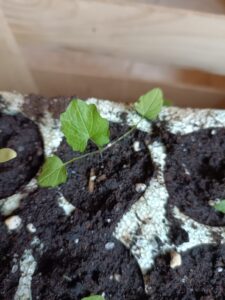 |
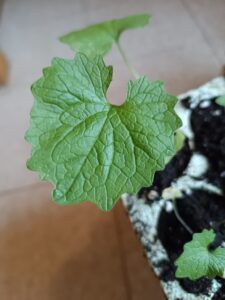 |
The lower leaves of the stem (second year) are reniform or cordate, with a crenate edge and a long petiole. Going upwards along the stem (figs. 3-6), the shape of the leaves changes from cordate-reniform to rhombic and pointed, passing through intermediate shapes with a truncated base (e.g., triangular). The upper leaves are shortly petiolate, pointed at the end and their margin is decidedly toothed
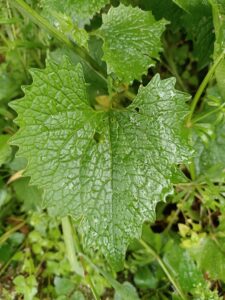 |
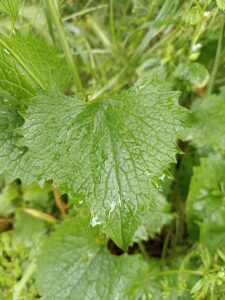 |
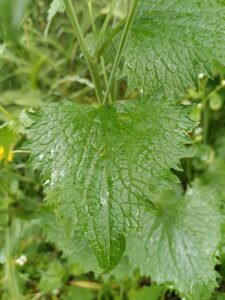 |
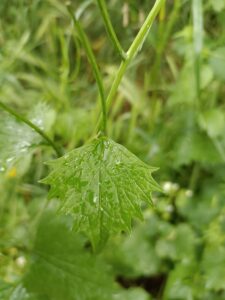 |
If we look at the development of the generic leaf in a diachronic manner, we can note the change, in first-year plants, from the triangular shape of the very young leaves to the kidney-like shape of more mature leaves (centrifugal “opening” of the leaf with widening and rounding and expansion beyond the petiole) possibly up to the cordate form of the adult ones (lengthening of the leaf axis with formation of the tip); in the second year of age, going up along the stem, the leaves change from reniform-cordate (lower leaves) to triangular and finally (at the top of the stem) to rhomboidal (narrowing or contraction of the leaf towards the leaf axis). In these last steps, the size of the leaf also gradually decreases, as if “closing” towards the axis and shortening at the same time.
The contractive process of the formation of the upper cauline leaves is followed by a new expansion with formation of the inflorescence and final re-contraction towards the siliqua.
It is therefore a process of rhythmic alternation between contraction and expansion (breadthwise) and between lengthening and shortening (lengthwise).
At flowering, the leaves are inserted on the stem in an alternate but not regular manner, so much so that in some points they may rather looks as forming a spiral phyllotaxis.
The sweetly scented flowers are typical of Brassicaceae, with four small, white petals arranged in a cross and six stamens, and are gathered in corymbose racemes.
The seeds are produced in erect, slender green pods (siliques) which turn pale brown when mature.
After the fertilization of the flowers and during the formation of the siliques, the terminal portion of the stem (the portion on which the flowers are attached) lengthens upwards transforming the corymbose (and therefore in a certain sense “shortened”) raceme that bears the flowers into an elongated raceme, thus continuing the alternation between shortening and lengthening already seen in the leaves.
The arrangement of the siliques along the stem axis is once again between spiral and alternate and sometimes it is also possible to find pairs of siliques placed roughly at the same height on the stem, i.e. looking almost opposite; figs. 7-8).
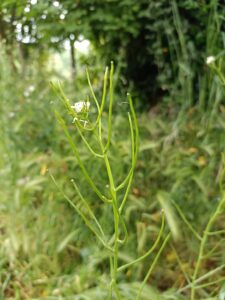 |
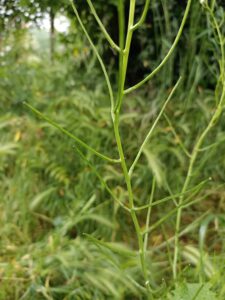 |
Observing the plant in its growth process, we can see that in the first year it tends to remain low and oriented towards the ground, with the leaves hanging down. When the flowering process starts, the whole plant begins to orientate decidedly upwards and, during anthesis, while the leaves keep hanging downwards, the stem and the flowers grow and orient themselves towards the light. Even during the formation and ripening of the seeds, the terminal part of the stem lengthens, as we have already seen, and at the same time the siliques rise as much as they can by “pushing” their terminal ends (that is, the ends not attached to the stem) upwards. It almost seems that, if in the dimension of the leaf garlic mustard tends to look for the damp and shady environment of the layers next to the forest floor, in the flower and in the seed, instead, the plant tends to intensely seek the solar light and heat that it initially shunned, thus inserting himself into a kind of polarity between shadow and light, water and air, dampness and heat, soil and space, yin and yang.
The cyanide process in Alliaria
Brassicaceae are known to contain glucosinolates, sulfur glucosides characterized by the presence of a β-thioglucosidic bond. Alliaria, in particular, mainly contains sinigrin (fig. 9) [Cipollini].

When fresh tissues of Brassicaceae are injured, the enzymatic hydrolysis of the glucosinolates by the endogenous enzyme myrosinase produces an unstable molecule (thiohydroximate-O-sulfonate) which spontaneously decomposes producing isothiocyanates (the molecules mainly responsible for the pungent taste of these plants), thiocyanates, nitriles or other molecules depending on the reaction conditions [Natarajan, Nguyen, Tanii]. Small amounts of hydrogen cyanide (HCN) are also typically released in this process.
Unlike other Brassicaceae which emit only traces of HCN, A. petiolata is able to produce significantly higher quantities. One study reported that the young leaves of some garlic mustard plants were able to produce over 100 p.p.m. of HCN with respect to their fresh weight, a level considered to be (potentially) acutely toxic to humans and other vertebrates. In other experiments, levels in leaves ranged from 20 to 85 ppm (with a mean of 44 ± 2 p.p.m.), levels that are still considered to be moderately toxic4. The younger leaves of first-year plants release more cyanide that the older leaves. Less cyanide release was detected from roots. [Cipollini2]
A. petiolata is the Brassicacea that produces the largest amount of HCN by far: Brassica rapa and B. napus, for example, produce over 150 times less. [Cipollini2]
Hydrogen cyanide (HCN) release from A. petiolata is probably due to a plant-specific enzymatic pathway from glucosinolates via allylthiocyanate and indole glucosinolate derived thiocyanate ion to HCN [Frisch3], since sinigrin decomposition in vitro by means of thioglucosidase from Sinapis alba fails to produce any detectable amount of cyanide [Cipollini2].
The “affinity” of garlic mustard for cyanide and its compounds is seen in yet another aspect. The plant produces an organic molecule containing a cyanide group (nitrile): alliarinoside ((2Z)-4-(beta-d-glucopyranosyloxy)-2-butenenitrile; fig. 10), a glycoside whose aglycon ((Z)-4-hydroxy-2-butenenitrile) is a γ-hydroxynitrile.
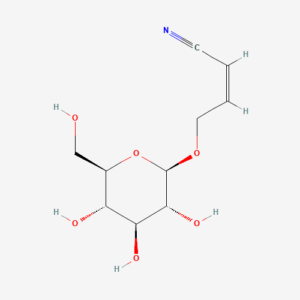
Hydroxynitrile glucosides are often found in plants. The so called “cyanogenic glucosides” (e.g., prunasin) have unstable α-hydroxynitrile aglycons which, upon hydrolysis induced by glucosidases, readily decompose spontaneously releasing HCN, which is generally toxic to respiring organisms [Bjarnholt]. These molecules generally act as antifeedant, since they release cyanide when they come into contact with the endogenous hydrolyzing enzymes released when the plant tissues are broken.
β- and γ-hydroxynitriles, instead, are stable and do not release HCN upon hydrolysis of their glucosides [Bjarnholt, Frisch2]. This means that the alliarinoside aglycon, too, is stable upon hydrolysis and does not contribute to the HCN released by the plant.
The biological functions of β- and γ-hydroxynitrile glucosides are yet to be resolved. The aglycons of γ-hydroxynitrile glucosides have been suggested to rearrange to furanones with antifungal and antimicrobial properties. This also may apply to alliarinoside, and thus may contribute to the known inhibition of mycorrhizal fungi by A. petiolata. [Frisch]
Together with other molecules contained in the plant, alliarinoside appears to act as a feeding deterrent for some insects. [Cipollini2]
It’s interesting to note that hydroxynitrile glucosides and glucosinolates are not usually found at the same time in the same plant species. Garlic mustard is one exception to this rule and is also the single known case of γ-hydroxynitrile glucoside occurrence in Brassicaceae, a botanical family where no β-hydroxynitrile glucosides have been described. [Bones, Frisch2]
Cyanides in homeopathy and their relations with some plant remedies
The cyanide group consists of a carbon atom bonded to a nitrogen atom with a triple bond. This arrangement leaves a free electron on the carbon atom which allows the formation of organic (nitriles) or inorganic compounds. In the latter case, the cyanide group behaves like an anion with a single negative charge and can bind to any cation to form a salt (again called cyanide). Cyanides are among the deadliest poisons known to man.
Given its structure and the presence of a single electron available for bond formation, the cyanide group behaves chemically quite like halogens (in fact, it is sometimes referred to as a “false halogen”).
Moreover, the cyanide ion forms coordination compounds with iron, called ferrocyanides, in which six cyanide ions are bonded to a central iron ion to form a tetravalent anion, Fe(CN)64-, which clearly can only exist in the form of salts with metallic cations.
The chemical analogy between cyanide and halogens is found, in some ways, also in the homeopathic remedies prepared with these substances.
In homeopathy, the main feature of cyanides is the feeling of betrayal, which, in this case, is similar to Iodine’s feeling of being stabbed in the back (it is therefore a matter of life and death). [Morrison]
The whole group of cyanides is characterized by delusions related to murder, betrayal and an enormous fear. For the patient, the first way to cope with these sensations is to cling to those around him. If this strategy is not effective, or if the perceived threat comes from someone close to him, he fights the threat angrily and offensively, with bites, fights and violence. If even this is useless, he gives up, loses hope and loses touch with reality or develops suicidal instincts. [Morrison]
To understand this behavior, we can reflect on the mental state of a prisoner sentenced to death, tied to a chair, left alone in a gloomy room, aware that a few moments separate him from death. He may scream for help, cry violently, yell or bite those around him. Yet this behavior is in vain and he knows it. [Morrison]
Although the patient generally acts rather cheerfully, the mental state is focused on fear. We find fear of death, dreams of dead bodies, fear of the house collapsing on him, and fear of going to sleep. The patient perceives a feeling of imminent threat that gives rise to a strong desire for company and a fear of being left alone. For this reason, the patient falls into a comforting fantasy in which he imagines he is with friends, tries to reach them and calls them by name. [Morrison]
Cardiac symptoms (angina pectoris, violent palpitations, bradycardia or tachycardia, irregular and/or weak pulse, cardiac arrest) are important physical symptoms of cyanides. [Morrison]
The patient may scream in pain and fear. This apprehension can be accompanied by the confusion typical of organic remedies. When such confusion is extreme, the patient is lost and disoriented and may have difficulty thinking, distractedness, lack of memory for appointments. [Morrison]
Other typical physical characteristics of cyanides are: spasms, especially of the hands, face and throat; cyanosis; contractures; cancer, especially of the tongue (but also of the rectum, as in Kali Cyanatum); convulsions and petit mal. As with true halogens, there are many symptoms relating to the throat and larynx. [Boericke, Morrison]
There are almost always breathing difficulties that cause “shortness of breath”:
- Hydrocyanicum Acidum (Hydr-Ac.): very slow, irregular breathing, rapid breathing or gasping; asthma; asphyxiation; respiratory arrest; dry, irritating, itchy cough; whooping cough; choking in the throat.
- Kali Cyanatum (Kali-Cy.): markedly slowed breathing; rapid breathing; Cheyne-Stokes respiration; cannot take deep breaths; asthma; asphyxiation.
- Kali Ferrocyanatum (Kali-Fcy.).: asthma.
- Mercurius cyanatum (Merc-Cy.): membranous croup; dyspnea; feeling of paralysis of the lungs.
- Zincum Cyanatum (Zinc-Cy.): short inspiration and prolonged expiration. [Boericke, Phatak, Morrison, Scholten]
Other recurring symptoms are: absence, frequent (Hydr-Ac. Merc-Cy. Zinc-Cy); pain anxiety (Hydr-Ac. Merc-Cy.); fear of death (Hydr-Ac. Kali-Fcy.); bluish coloration of the face (Hydr-Ac. Kali-Cy.); face, old expression (Hydr-Ac. Kali-Fcy.); swallowing, difficult (Hydr-Ac. Kali-Cy. Merc-Cy.). [Morrison]
In ferrocyanides, the bond between the central iron ion and the coordinated cyanide groups is very strong and therefore very stable. This produces a significant decrease in the chemical reactivity of the cyanide ions involved in the bond, so much so that the resulting compounds are practically non-toxic (potassium ferrocyanide has been used for a long time as an anti-caking agent in table salt). In parallel with the decrease in the chemical reactivity of cyanide, in ferrocyanides a strong decrease in the “reactivity” of the patient is observed, so that, for example, the intense fear and violence typical of cyanides are absent. Rather than feeling betrayed, the patient feels repressed (a key aspect of Ferrum remedies) and reacts using his own willpower, often excessively so as to become despotic (cf. [Morrison]).
Cyanide is strongly linked to the rose family (Rosaceae). Many of these plants, indeed, contain cyanide glycosides, molecules that can be converted to hydrocyanic acid in the stomach on eating parts of the plant (usually the seeds, sometimes also the leaves).
This large family has some peculiar, common features: the sweetness of the fruit, the thorniness of its protection, and the quality of breathlessness and suffocation, brought on by the cyanides within the plants. [Scholten]
Many plants belonging to this family are used, both in herbal medicine and in homeopathy, to address heart problems, either related to the physical or to the emotional heart (eg., the “center” of emotions), like heart complaints due to problems in love relationships. [Scholten]
Jan Scholten has described the overall theme of the Rosaceae as “the pain of a broken heart”; the heart and circulation are generally where the problems manifest most clearly. Each of the various members of this family deals differently with issues of romantic love. [Scholten]
People needing a remedy from the rose family can have a tendency to idealize love and to give more than they receive. They live for their love so much that there is no space left for them, no room to breathe. If their love is unfulfilled or deceived, they can become ill, both physically and emotionally. Then, they can become irritable, making nasty remarks, or expressing their irritation constantly, showing their thorny side. [Scholten]
The connection with cyanide is strongly apparent in rose family. These plants, indeed, share several symptoms with cyanides: convulsions and contractions, epilepsy, trismus, opisthotonus; respiration problems, with obstructed respiration, asthma, dyspnea; heart-related problems, like arrhythmia, infarction, failure, decompensation, dilatation, hypertension, hypotension, angina pectoris. Rosaceae tend to be cyanotic and have blue discoloration of lips, nails, face, arms (Laurocerasus is one of the best known remedies for cyanosis). [Boericke, Phatak, Morrison, Scholten]
Hydrocyanic acid is considered the acute remedy (stage 1, according to Scholten classification) of the rose family: one of the most lethal poisons known to man, it has been used in the ultimate form of lovelessness, extermination (in the holocaust gas chambers). [Scholten]
Also Brassicales show some relations with cyanide. The plants belonging to this order contain glucosinolate, sulfur compounds which, on hydrolysis, can release small amounts of cyanide. According to Jan Scholten, also in Brassicales, like Rosaceae, we find the themes of love and getting no air for oneself. [Scholten]
Love is important aspect, here. It can be love in general, for the world, for the friends and family, but it is often especially focused on married love. They can be very loving and giving, but later in life this can turn into a worn-out state, a state of being empty, wrinkled, used and abused. [Scholten]
In the Brassicaceae family, specifically, there is lack of harmony, humour, love, warmth. They have the feeling that there is no more fun in life, the harmony and beauty are gone, and that there is no love for them. They feel unloved, feel that their partner does not really love them; this can even go to the feeling that God does not love them. [Scholten]
Interesting enough, the Brassicaceae delusions are: he is dead, or will die, has unrecognised disease; alone in a graveyard, has been poisoned (cyanide is a strong poison). [Scholten]
Properties
Temperature and taste
Garlic mustard is hot and dry, but less so than garlic [Durante, Mattioli]. According to John Gerard, it is “hot and dry in the end of the second degree, or in the beginning of the third” [Gerard].
The fresh leaf is decidedly aromatic (between garlic and rocket), sweet, pungent (like rocket), slightly salty and slightly mucilaginous. The sweet taste (more intense) and the saline one (less intense) are perceived quite importantly. The sweet and the pungent tastes are persistent.
Signature
According to Culpeper, “it is an herb of Mercury”. [Culpeper]
Tissue Phases
N/A
Actions and indications
Humoral actions
Garlic mustard is a spicy and aromatic plant and, as such, it is diffusive, provides warmth and eliminates stagnation of tension, phlegm and blood. In particular, it resolves the toxic heat that manifests with putrefaction, and expels thickened phlegm.
Tropism
Skin and mucous membranes (epithelia), respiratory system, digestive system, urinary system.
Clinical actions
Anthelmintic, anti-asthmatic, anticatarrhal, anti-hysteric, anti-inflammatory, anti-scorbutic, antiseptic, antispasmodic, antitussive, aperitive, astringent, carminative, cholagogue, deobstruent, depurative, diaphoretic, digestive, diuretic, expectorant, febrifuge, purifying, spasmolitic, stimulant, stomachic, tonic, vermifuge, vulnerary.
Principal actions
- Anti-asthmatic. [Dunglison, Lewis, Mueller, Peroni, Vermeulen]
- Anti-catarrhal. [Peroni]
- Anti-hysteric [Durante, Mattioli]:
- Liter.: “External. The seed applied to the nature of women in the form of a poultice, frees them from the prefocation5 of the matrix, & awakens them.” [Durante]
- Anti-inflammatory [Arsia]:
- Liter.: “the infusion made with the aerial parts is administered orally as a generic systemic anti-inflammatory.” [Arsia]
- Anti-scorbutic. [Arietti2, Dunglison, Peroni, Quer, Vermeulen]
- Antiseptic [Guarino, Lewis, Mueller, Peroni, Vermeulen], anti-putrid [Arietti, Arietti2, Peroni]:
- The juice inhibits gram-negative bacteria of the typhoid-paratyphoid-enteritis group. [Vermeulen]
- externally as an antiseptic, in gangrenes and putrid ulcers. [Lewis]
- Liter.: “Antiputrid and detergent in purulent ulcerations such as those of chilblains.” [Arietti2]
- Aperitive. [Durante]
- Astringent. [Arietti]
- Bechic. [Arietti2, Culpeper, Hill]
- Carminative [Arietti2, Culpeper, Gerard]:
- Liter.: “Some also boile the leaues in clisters which are vsed against the paine of the collicke and stone, in which not only winde is notably wasted, but the pain also of the stone mitigated and very much eased.” [Gerard]
- Liter.: “Added to sauces, they give them a more pronounced flavor and make them more digestible, also avoiding the production of putrid gases in the intestine.” [Arietti2]
- Cholagogue. [Mueller]
- Deobstruent [Lewis, Vermeulen]:
- in asthmatic disorders. [Lewis]
- Depurative [Peroni], purifying [Guarino].
- Diaphoretic. [Arietti2, Dunglison, Lewis, Mueller, USDisp, Vermeulen]
- Very powerful diaphoretic [Lewis].
- Digestive [Durante], stomachic [Mueller], stimulant of gastrointestinal secretion [Arietti, Guarino, Peroni]:
- to excite gastrointestinal secretions and slow down fermentation (5% whole plant infusion, 2-3 cups a day). [Peroni]
- Diuretic [Arietti2, Hill, Dunglison, Lewis, Mueller, Quer, USDisp]:
- Liter.: “The fresh leaves eaten as salad work by urine powerfully, and are recommended in dropsies.” [Hill]
- Expectorant. [Culpeper, Mueller, USDisp]
- Febrifuge. [Mueller]
- Spasmolytic, antispasmodic [Arietti, Guarino, Mueller, Peroni]:
- 3% whole plant medicated wine, 2-3 small glasses a day. [Peroni]
- Stimulant [Arietti2, Quer, Mueller], “provocative” [Durante].
- Tonic. [Mueller]
- Vermifuge [Arietti2, Peroni, Vermeulen], anthelmintic [Mueller]:
- Seeds are antiscorbutic and vermifuge. [Peroni]
- Vulnerary. [Vermeulen, Guarino, Peroni]
Specific indications
General
- Cancer (of stomach, pylorus, duodenum); cancerous affections [Mueller], cancer diathesis. [Mueller]:
- Liter.: “Posology. For cancer of the pylorus, fresh plant tincture; single drop dose. For cancer in general, fresh juice, 2 to 4 ounces per day or as desired.” [Mueller]
- Allergies. [Mueller]
Mouth
- Gingival inflammation. [Peroni]
Respiratory system
- Cough. [Culpeper, Hill]
- Angina (8% whole plant infusion, for gargling). [Peroni]
- Hoarseness (syrup made with plant juice) [Dunglison, Hill, Peroni], aphonia (8% whole plant infusion, for gargling). [Peroni]
- Asthma, humid asthma, dyspnoea. [Dunglison, Mueller, Peroni]
- Smoke from the flowering tops: inhaled in asthma attacks. [Peroni]
- Bronchitis. [Mueller]
- Catarrh of the respiratory tract (tincture). [Peroni]
Digestive system
- Ulcers (stomach, duodenum) [Mueller]:
- “in patients with a tendency to indolent ulcers that are slow to heal, or a history of H. pylori, or other infections of the digestive tract, painful indigestion, and ulceration of the stomach and duodenum.” [Mueller]
- Chronic gastritis. [Mueller]
- Cancer of stomach, pylorus, duodenum. [Mueller]
- Thickening at the pyloric extremity of the duodenum. [Mueller]
- Bowel colic (due to intestinal gas) [Culpeper, Durante, Gerard]:
- Liter.: “These leaves are put in the decoctions that are made for enemas suitable for colic and renal pains, with very great benefit, because they dissolve the windiness and mitigate the pains.” [Durante]
- Intestinal worms (tincture, seeds) [Arietti2, Peroni, Vermeulen]:
- 5% seed infusion, three small glasses a day; seed tincture, 40-60 drops three times a day. [Peroni]
- Colibacillosis (juice, 20-40 g per day). [Peroni]
Kidneys and urinary system
- Kidney stones. [Culpeper]
- Kidney colic (due to stone passage). [Culpeper, Durante, Gerard]
Limbs
- Edema of legs. [Mueller]
Skin
- Sores, suppurations, ulcers, torpid ulcers [Culpeper, Durante, Mueller, Peroni, Vermeulen]:
- Skin ulcers and slow healing of wounds. [Mueller]
- Sores and suppurations (cataplasm of fresh leaves bruised, external use). [Peroni]
- Torpid sores and ulcers (8% whole plant infusion, for washings; fresh juice, in dressings which must be renewed every day until the sore is reabsorbed). [Peroni]
- Tincture: added to water for compresses and washing, on torpid ulcers. [Peroni]
- Gangrene [Lewis]:
- Liter.: “Boerhaave informs us, that he cured a gangrene of the leg, arising from a neglected fracture and contusion, by applying the leaves of alliaria bruised with wine.” [Lewis]
- Malignant ulcers. [Mueller, Quer]
- Pustular dermatitis (8% whole plant infusion, as a wash). [Peroni]
- Ulcerated chilblains (10% whole plant decoction, external use). [Peroni]
- Impetigo (10% whole plant decoction, external use). [Peroni]
Parts used and their collection
The stems and leaves should be collected when they are well developed and the plant is about to flower. [Quer]
The flowering tops or the entire flowering plant can be collected when the flowers are well developed.
The roots, at the beginning of the second year, when the plant begins to grow taller [Quer] or at the end of the first year, in autumn.
Preparation and dosage
The plant should be used fresh. The juice can be extracted with a press or by pounding the plant in a mortar and then straining it through a cloth and squeezing out the residue. The juice can be used fresh or stabilized with at least 20-25% alcohol (95-96° or 180 proof).
The tincture should be prepared from the fresh plant.
Contraindications and collateral effects
Garlic mustard plants contain a variable amount of cyanide precursors (see paragraph “The cyanide process in Alliaria”).
Anyhow in order to produce adverse effects, a large amounts of fresh, raw herb should be ingested at once. No references have been found till now about any toxicity or adverse effects due to intake of garlic mustard. So, it is to be considered safe when used appropriately.
Homeopathy
Alliaria petiolata has not been proved in homeopathy. Apart from some occasional reference to it (for instance, in Cooper, see [Mueller]), the plant has not been used, in fact, in homeopathy.
References
|
[Acta] |
https://www.floraitaliae.actaplantarum.org/viewtopic.php?f=95&t=258 (Retrieved: 2022-04-20) |
|
[Bjarnholt] |
Nanna Bjarnholt, Birger Lindberg Møller, “Hydroxynitrile glucosides”, Phytochemistry 69 (2008) 1947–1961; DOI:10.1016/j.phytochem.2008.04.018 |
|
[Bones] |
Bones AM, Hara M, Rossiter JT and Kissen R, “Editorial: Physiology and Cellular Mechanisms of Isothiocyanates and Other Glucosinolate Degradation Products in Plants.”, Front. Plant Sci. 6:1105 (2015); DOI: 10.3389/fpls.2015.01105 |
|
[Burke] |
David J. Burke, “Effects of Alliaria petiolata (garlic mustard; Brassicaceae) on mycorrhizal colonization and community structure in three herbaceous plants in a mixed deciduous forest”, American Journal of Botany 95(11): 1416–1425. 2008; DOI: 10.3732/ajb.0800184 |
|
[Culpeper] |
Nicholas Culpeper, “The Complete Herbal” (1653) |
|
[Cipollini] |
Don Cipollini, “Variation in the expression of chemical defenses in Alliaria petiolata (Brassicaceae) in the field and common garden”, American Journal of Botany 89(9): 1422–1430 (2002); DOI: 10.3732/ajb.89.9.1422 |
|
[Cipollini2] |
Don Cipollini, Bill Gruner, “Cyanide in the Chemical Arsenal of Garlic Mustard, Alliaria petiolata”, J Chem Ecol 33, 85–94 (2007). DOI: 10.1007/s10886-006-9205-x |
|
[Dunglison] |
Robley Dunglison, “Medical Lexicon: A Dictionary of Medical Science”, 3.rd ed., Phyladelphia (1853) |
|
[Durante] |
Castore Durante, “Herbario nuovo” (1667) |
|
[Frisch] |
Frisch, T., Agerbirk, N., Davis, S. et al. “Glucosinolate-Related Glucosides in Alliaria petiolata: Sources of Variation in the Plant and Different Metabolism in an Adapted Specialist Herbivore, Pieris rapae”, J Chem Ecol 40, 1063–1079 (2014); DOI: 10.1007/s10886-014-0509-y |
|
[Frisch2] |
Tina Frisch and Birger L. Møller, “Possible evolution of alliarinoside biosynthesis from the glucosinolate pathway in Alliaria petiolata”, FEBS Journal 279 (2012), 1545–1562; DOI: 10.1111/j.1742-4658.2011.08469.x |
|
[Frisch3] |
Tina Frisch et al., “Diversified glucosinolate metabolism: biosynthesis of hydrogen cyanide and of the hydroxynitrile glucoside alliarinoside in relation to sinigrin metabolism in Alliaria petiolata”, Front. Plant Sci. 6:926 (2015); DOI: 10.3389/fpls.2015.00926 |
|
[GBIF] |
https://www.gbif.org/species/5376078 (Retrieved: 2022-04-20) |
|
[Gerard] |
John Gerard, “The Herball or Generall Historie of Plantes”, London (1636) |
|
[Guarino] |
Carmine Guarino et al., “Ethnobotanical Study of the Sannio Area, Campania, Southern Italy”, Ethnobotany Research & Applications 6:255-317 (2008). |
|
[Hill] |
John Hill, “The Family Herbal” (1812) |
|
[Kew] |
https://powo.science.kew.org/taxon/urn:lsid:ipni.org:names:77122966-1 (Retrieved: 2022-04-20) |
|
[Kress] |
https://henriettesherb.com/plants/alliaria/petiolata.html (Retrieved: 2022-04-20) |
|
[Lewis] |
William Lewis, “An Experimental History Of The Materia Medica”, J. Johnson & R. Baldwin, London (1784) |
|
[Mattioli] |
Pietro Andrea Mattioli, “Discorsi di M. Pietro Andrea Mattioli sanese, medico cesareo, ne’ sei libri di Pedacio Doscoride Anazarbeo della materia Medicinale” (1746) |
|
[Morrison] |
Roger Morrison, “Carbonio – Rimedi Organici e Idrocarbonici in Omeopatia”, Bruno Galeazzi Editore (2012); orig.: “Carbon – Organic and Hydrocarbon Remedies in Homeopathy”, Hahnemann Clinic Publishing (2006) |
|
[Mueller] |
Manfred Mueller, “Homeopathic Cancer Drugs – Oncology Materia Medica”, 2nd ed., The Other Medicine Publications (2019) |
|
[Natarajan] |
Natarajan S, Thamilarasan SK, Park JI, Chung MY, Nou IS, “Molecular Modeling of Myrosinase from Brassica oleracea: A Structural Investigation of Sinigrin Interaction”,Genes (Basel). 2015 Dec 21;6(4):1315-29. doi: 10.3390/genes6041315. PMID: 26703735; PMCID: PMC4690043. |
|
[Nguyen] |
Nguyen VPT, Stewart J, Lopez M, Ioannou I, Allais F, “Glucosinolates: Natural Occurrence, Biosynthesis, Accessibility, Isolation, Structures, and Biological Activities”, Molecules. 2020 Oct 3;25(19):4537. doi: 10.3390/molecules25194537. PMID: 33022970; PMCID: PMC7582585. |
|
[Peroni] |
Gabriele Peroni, “Driope – ovvero il patto tra l’uomo e la natura”, Nuova Ipsa Editore (2012) |
|
[Phatak] |
S. R. Phatak, “Materia Medica of Homoeopathic Medicines”, 2.nd edition, B. Jain Publishers (P) Ltd. (1999) |
|
[Poon] |
Poon GT, Maherali H. (2015), “Competitive interactions between a nonmycorrhizal invasive plant, Alliaria petiolata, and a suite of mycorrhizal grassland, old field, and forest species”, PeerJ 3:e1090 https://doi.org/10.7717/peerj.1090 |
|
[POWO] |
https://powo.science.kew.org/taxon/urn:lsid:ipni.org:names:330037-2 (retrieved: 2023-05-19) |
|
[Prati] |
Daniel Prati and Oliver Bossdorf, “Allelopathic Inhibition of Germination by Alliaria Petiolata (Brassicaceae)”, American Journal of Botany 91(2): 285–288. 2004; DOI: 10.3732/ajb.91.2.285 |
|
[PubChem] |
PubChem Identifier: CID 10582490 URL: https://pubchem.ncbi.nlm.nih.gov/compound/10582490#section=2D-Structure From: National Center for Biotechnology Information (2023). PubChem Compound Summary for CID 10582490, Alliarinoside. Retrieved May 16, 2023 from https://pubchem.ncbi.nlm.nih.gov/compound/Alliarinoside. |
|
[Quer] |
Pío Font Quer, “Plantas Medicinales – El Dioscóride Renovado”, Ed. Península, Barcelona (2020) |
|
[Rice] |
Rice NC, Rauscher NA, Langston JL, Myers TM., “Behavioral toxicity of sodium cyanide following oral ingestion in rats: Dose-dependent onset, severity, survival, and recovery”, Food Chem Toxicol. 2018 Apr;114:145-154. doi: 10.1016/j.fct.2018.02.033. Epub 2018 Feb 16. PMID: 29454866; PMCID: PMC5860990. |
|
[Rodgers] |
Rodgers, V.L., Wolfe, B.E., Werden, L.K. et al., “The invasive species Alliaria petiolata (garlic mustard) increases soil nutrient availability in northern hardwood-conifer forests”, Oecologia 157, 459–471 (2008); DOI: 10.1007/s00442-008-1089-8 |
|
[Saul] |
Hayley Saul et al., “Phytoliths in Pottery Reveal the Use of Spice in European Prehistoric Cuisine”, PLoS One, 2013, Aug 21;8(8):e70583. doi: 10.1371/journal.pone.0070583 |
|
[Scholten] |
https://www.qjure.com |
|
[Spatafora] |
Placido Spatafora, “Prosodia italiana ovvero L’arte con l’uso degli accenti nella volgar favella d’Italia”, Ed. seconda veneta, Tomo II, Venezia (1820) |
|
[Tanii] |
Tanii H., “Allyl nitrile: Toxicity and health effects”, J Occup Health. 2017 Mar 28;59(2):104-111. doi: 10.1539/joh.16-0147-RA. Epub 2017 Jan 28. PMID: 28132970; PMCID: PMC5478528. |
|
[USDisp] |
Remington and Wood, “The US Dispensatory” (1918) |
|
[Vermeulen] |
Frans Vermeulen, Linda Johnston, “PLANTS – Homeopathic and Medicinal Uses from a Botanical Family Perspective”, Saltire Books (2011)[Vermeulen] |
|
[WFO] |
http://www.worldfloraonline.org/ (Retrieved: 2023-05-16) |
|
[Wikimedia] |
Public Domain, https://commons.wikimedia.org/w/index.php?curid=1428286 |
|
[Wolfe] |
Benjamin E. Wolfe, Vikki L. Rodgers, Kristina A. Stinson, Anne Pringle, “The invasive plant Alliaria petiolata (garlic mustard) inhibits ectomycorrhizal fungi in its introduced range”, Journal of Ecology 2008, 96, 777–783; DOI: 10.1111/j.1365-2745.2008.01389.x |
|
[WPost] |
https://www.washingtonpost.com/wp-srv/special/metro/urban-jungle/pages/130416.html (Retrieved: 2023-05-16) |
|
[Zennie] |
Thomas M. Zennie and C. Dwayne Ogzewalla, “Ascorbic Acid and Vitamin A Content of Edible Wild Plants of Ohio and Kentucky”, Economic Botany 31: 76-79. January-March, 1977. |
Notes
1. See “Notes on humors”.
2. Sisymbrium officinale (L.) Scop.
3. Hysterical disturbances: “prefocation of the matrix is called, when women fall like death because of the vapors of the matrix.” [Spatafora]
4. It is estimated that the median lethal dose (LD50) of HCN in humans is 1.0 mg/kg IV, 100 mg/kg via dermal exposure, and 1.52 mg/kg via the oral route [Rice]. The cyanide levels in A. petiolata could be concerning for mammals if large amounts of fresh leaves are ingested at once or eaten chronically, like a salad of fresh garlic mustard every day, which would be difficult to do, also because of the bitter taste of the plant. Cooking greatly reduces or eliminates cyanide (see [Wpost]).
5. V. nota 8.
Featured image from [Wikimedia].
